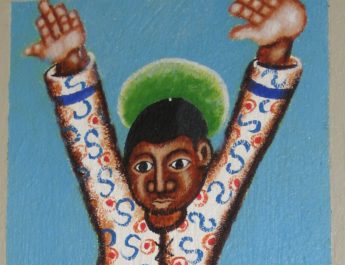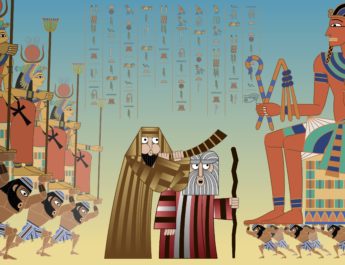Mark 9:2-4
NL 209
2 Six days later, JesusA took withB him PeterC and JamesD and John,E
A “Jesus” = Iesous. From Hebrew Yehoshua (Joshua, the Lord is salvation); {from YHVH (proper name of the God of Israel; the self-existent and eternal one); {from havah (to become) or from hayah (to come to pass, become, be)} + yasha (to deliver, defend, help, preserve, rescue; properly, to be open, wide or free, which implies being safe. So, in a causative sense, this is to free someone)}. This is Jesus or Joshua in Greek – the Lord saves or the Lord is salvation.
B “took with” = paralambano. From para (beside, by, in the presence of) + lambano (active acceptance/taking of what is available or what has been offered; emphasizes the choice and action of the individual). This is to receive, take, acknowledge, associate with. It can also mean to take on an office or to learn.
C “Peter” = Petros. Related to petra (large rock that is connected and or projecting like a rock, ledge, or cliff; can also be cave or stony ground). This is Peter, a stone, pebble, or boulder.
D “James” = Iakobos. From Hebrew Yaaqov (Jacob); from the same as aqeb (heel, hind part, hoof, rear guard of an army, one who lies in wait, usurper). This is James, meaning heel grabber or usurper.
E “John” = Ioannes. Related to “Jesus” in v2. From Hebrew yochanan (Johanan); from Yehochanan (“the Lord has been gracious”); {from YHVH (see note A above) + chanan (beseech, show favor, be gracious; properly, to bend in kindness to someone with less status). This is John.
and led them upF a highG mountain apart, by themselves.H And he was transfiguredI before them,
F “led…up” = anaphero. 10x in NT. From ana (up, back, among, again, anew) + phero (to bear, bring, lead, make known publicly; to carry in a literal or figurative sense). This is to carry or lead up as to a goal or particular destination. It can also be used for offering a sacrifice.
G “high” = hupselos. 12x in NT – in Matthew’s and Luke’s Temptation story as well as Matthew and Mark’s Transfiguration accounts. From hupsos (height, high position, heaven, dignity, eminence; elevation, altitude; to be exalted); from hupsi (on high, aloft); from huper (over, above, beyond). This is high, lofty, or exalted. It can be lofty in elevation or in character.
H “by themselves” = idios + monos. Idios is something that belongs to you or that is personal, private, apart. It indicates a stronger sense of possession than a simple possessive pronoun. This is where “idiot” comes from (denoting someone who hasn’t had formal training or education and so they rely on their own understanding). Monos is perhaps from meno (to stay, abide, wait, endure). It is alone, desolate mere, solitary, only.
I “transfigured” = metamorphoo. 4x in NT. From meta (with among, behind, beyond; implies a change following contact or action) + morpho (to form, mold, shape; coming into the shape that signified inner essence) {from morphe (form, shape, external appearance; an appearance that embodies inner essence; figuratively, the nature of something); {perhaps from meros (a part or share, portion); {from meiromai (to get one’s allotment or portion)}. This is to transform or change. It is the root that “metamorphosis” comes from.
3 and his clothesJ becameK dazzlingL white,M
J “clothes” = himation. From heima (garment) OR from ennumi (to put on). This is the outer garment, cloak, robe, or mantle. It is worn loosely over a tunic.
K “became” = ginomai. This is to come into being, to happen, become, be born. It can be to emerge from one state or condition to another or is coming into being with the sense of movement or growth.
L “dazzling” = stilbo. 1x in NT. This is to shine, be radiant, flash.
M “white” = leukos. Related to luke (light). This is bright, white, or brilliant.
such as no oneN on earth couldO bleachP them.
N “one” = gnapheus. 1x in NT. From knapto (to card wool). This is a launderer or fuller – who cleans wool.
O “could” = dunamai. This is to be able, or something that is possible. It can also be empowered or being powerful. The Greek word for “miracle” (dunamis) comes from this root.
P “bleach” = leukaino. Related to “white” in v3. 2x in NT – transfiguration in Mark and the robes of the elders made white with the blood of the Lamb in Revelation 7:14. From leukos (see note M above). This is to whiten.
4 And there appearedQ to them ElijahR with Moses,S who were talking with Jesus.
Q “appeared” = horao. To see, perceive, attend to, look upon, experience. Properly, to stare at and so implying clear discernment. This, by extension, would indicate attending to what was seen and learned. This is to see, often with a metaphorical sense. Can include inward spiritual seeing.
R “Elijah” = Elias. Related to “Jesus” and “John” in v2. From Hebrew Eliyyah (Elijah) {from el (God, god) + Yah (the shortened form of the name of the God of Israel; God, Lord); {from YHVH (see note A above)}. This is Elijah, “The Lord is God.”
S “Moses” = Mouses. From Hebrew Mosheh (Moses); from mashah (to pull out in a literal or figurative sense, to draw out) OR from Egyptian mes or mesu (child, son i.e. child of…). This is Moses – the one drawn out from the water, which is to say, rescued. If derived from the Egyptian, his name would share a root with Rameses and Thutmose.
Image credit: “Jesus is Transfigured” from The LUMO Project.




